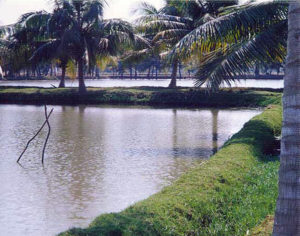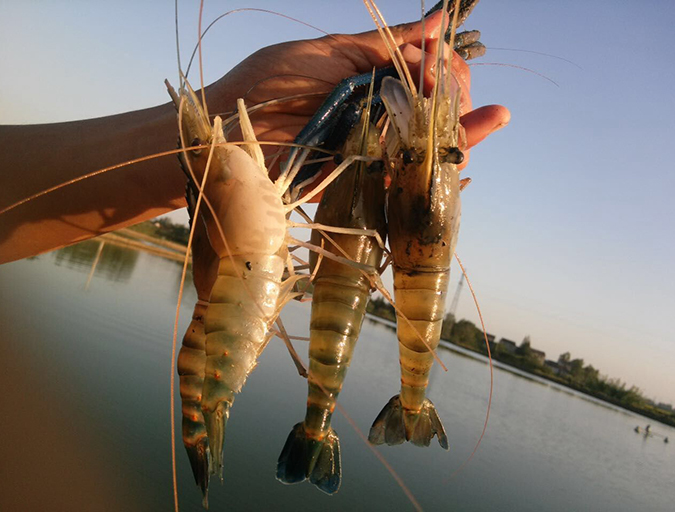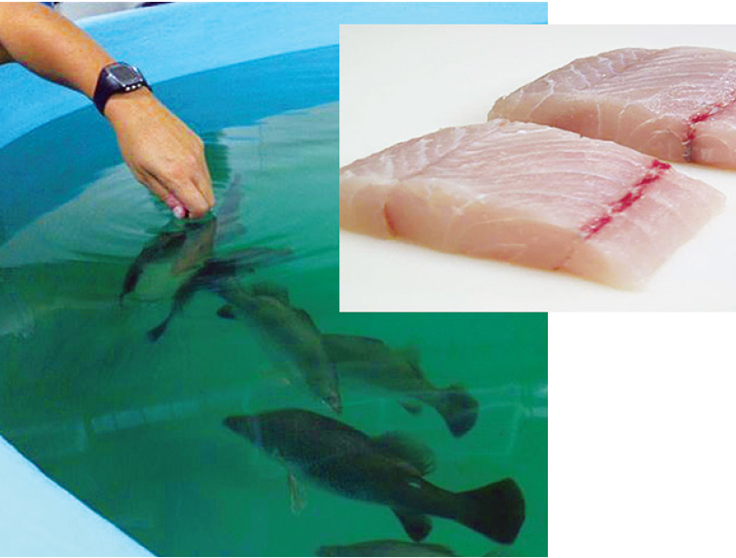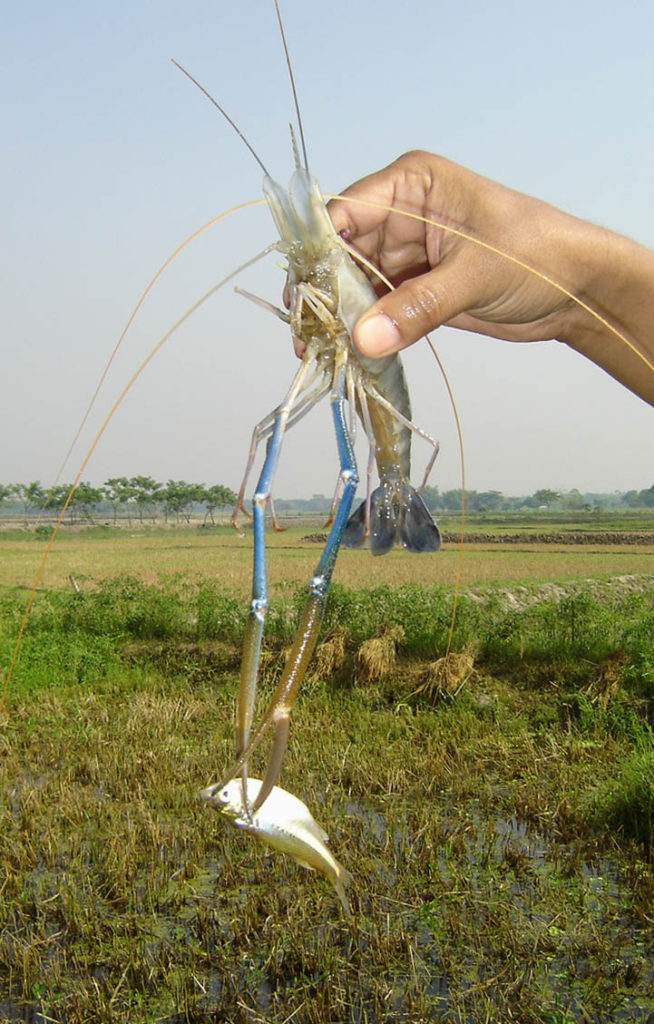Traditional industry moves toward modern practices

In India, where the per-capita intake of meat and milk is poor, fish and prawns play a vital role in supplementing and balancing people’s diets. About nine of the 39 species of the freshwater prawn genus (Macrobrachium) in India’s rivers are also considered commercially important. Two species – the Malaysian or giant freshwater prawn (Macrobrachium rosenbergii) and the riverine prawn (M. malcolmsonii) – are presently cultured in India. The smaller species (M. idea) mostly supports wild fishery catches.
Industry development
Freshwater prawn farming is undergoing expansion in many countries, but had been neglected in India until recently. However, after the setback suffered by the marine shrimp farming sector due to recent viral disease outbreaks, prawn farming is rapidly gaining momentum with the development of an export market with considerable price increases. India now contributes about 1,000 mt of the estimated 32,000 mt annual global production of freshwater prawns.
Freshwater prawn culture in India is undergoing a moderate transformation from traditional level to highly productive semi-intensive culture through intensive research and development efforts by the Indian Council of Agriculture Research, and various universities and state fishery departments.
The traditional production method is to stock and hold young prawns in ponds, tanks, rice fields, and other production systems, and harvest them after a considerable growout time. In recent years, increased juvenile collection from nature and the establishment of hatcheries have provided incentives for prawn culture in India’s coastal states. Some inland states are also keen to adopt technologies that utilize the abundantly available saline water for seed production to sustain this lucrative industry.
Hatchery management
Attempts to breed riverine prawns after success with giant freshwater prawns in hatcheries have led to large-scale seed production. A variety of hatchery systems – including indoor and outdoor, extensive backyard hatcheries, and those using clear water, green saline water, or artificial seawater – have developed, and each has specific advantages depending on local conditions.
Giant freshwater prawns breed year-round in parts of India where water temperatures range 28-32 degrees C. Animals attain maturity at around six months and breed four or five times during the season. Gravid females are collected from earthen ponds or natural habitats and held in fiberglass tanks or large plastic pools. Water is usually exchanged and aerated, and animals are fed daily with mussels, oil cake, and rice bran.
The prawns are kept at a ratio of 1 male:2-4 females, and artificial shelters are provided to prevent cannibalism. Mating occurs within a few hours of molting. The fertilized eggs are released on the pleopods within 24 hours. Incubation takes 22 to 24 days, after which the berried females are ready to release the hatchlings.
Larval rearing
Recently a simple, inexpensive outdoor system for seed production was developed at the Central Institute of Freshwater Aquaculture. The system uses 11 to 13 ppt seawater, and the main larval diets supplied to the animals are chopped worms and mussels.
Compared to indoor rearing, this new system reduces water exchange, electricity use, and feed costs, and cuts rearing time by 20 percent. The saline water rearing medium is replaced gradually with filtered freshwater over a period of 24 hours. Heavy mortality – mostly due to cannibalism – can occur if the acclimation process is delayed. Juveniles are packed at 50 animals per liter for transport to grow-out areas.
Feed, feed formulation

The optimal protein level for Macrobrachium is probably 27 to 35 percent, with somewhat higher needs for juveniles. Some researchers believe the animals exhibit negative growth if dietary protein exceeds 40 percent. M. rosenbergii have qualitative requirements for the same 10 amino acids essential to penaeid shrimp, except lysine. A tentative lysine requirement was established at 1.4 percent of diet in M. rosenbergii.
In India, polysaccharides at levels of 30 to 40 percent of dry diets are used for freshwater prawns. Additional research is needed to define the carbohydrate requirements of the giant freshwater and riverine prawns at various stages of growth and development under different farm conditions.
Essential fatty acids of the linolenic series have greater value to marine crustaceans, while the macrobrachiums require more linoleic series or a mixture of both. A dietary requirement of 1 to 2 percent linolenic acids is indicated for freshwater prawns. An absolute requirement for cholesterol by M. rosengergii and M. malcolmsoni is unconfirmed.
Little information is available on the vitamin and mineral requirements of freshwater prawns. However, it is known that insufficient vitamin levels cause cessation or retardation of metamorphosis and result in high mortality during prawn larval development. A deficiency of ascorbic acid leads to blackening of the esophagus wall, cuticle, gastric wall, hind gut wall and gills.
Macrobrachium aquaculture
Freshwater prawns are among the best species for culture because they can be grown in both fresh and low-salinity waters. They are omnivorous and hardy, and have the maximum growth potential among the cultured prawns. Freshwater prawns are in demand in both local and export markets. Data on the aquaculture production of various Macrobrachium species is given in Table 1.
Sukumaran, Aquaculture production of freshwater prawns, Table 1
| Species | Stocking Density (juveniles/m2) | Culture Period (days) | Production (kg/ha/crop) | Survival (%) |
|---|
Species | Stocking Density (juveniles/m2) | Culture Period (days) | Production (kg/ha/crop) | Survival (%) |
|---|---|---|---|---|
| Extensive | ||||
| M. rosenbergii | 3-5 | 180 | 280-984 | 58.5-62.8 |
| M. malcomsonii | 5 | 160 | 440-999 | 44.2-75.0 |
| Semi-Intensive | ||||
| M. rosenbergii | 10 | 180-210 | 1,662-2,280 | 58.5-74.7 |
| M. rosenbergii | 246 | 805 | ||
| M. rosenbergii | 115 | 506 | ||
| Extensive Polyculture | ||||
| M. rosenbergii | 1.02-1.50 | 240 | 300-500 | 60.2-74.7 |
| Catla catla (60%) | 3,500 | |||
| Labeo rohita (40%) | ||||
| Semi-Intensive Polyculture | ||||
| M. rosenbergii | 5 | 240 | 826-1,216 | 74 |
| Catla catla (60%) | ||||
| Labeo rohita (40%) | 3,500 | |||
| Intensive Polyculture | ||||
| M. rosenbergii | 365 | |||
| Silver carp, Catla rohu, grass carp, Mrigal carp, common carp, Notopterus chitala | 10,000 | 365 | 7,090-8,496 (including prawns) | 88.6-100 |
Low-level farming
When lowlands are dewatered for paddy cultivation, Macrobrachium juveniles are often obtained. A part of these are used for limited farming. In West Bengal, the seeds are collected from the open waters and sold to farmers. Organized commercial farming of M. rosenbergii and M. malcolmsonii started rather recently in India.
M. rosenbergii
A preliminary culture trial of M. rosenbergii in a channel in the coconut groves at the Regional Research Station in Kumarakom obtained a production of 805 kilograms per hectare per 246 days. Another trial conducted in a Pokkali field gave a production of 506 kilograms per hectare per 115 days. In some studies of intensive farming with proper feeding, manuring, and wa-ter quality control, production over 3,300 kilograms per hectare per year was achieved.
M. rosenbergii gave a production range of 280 to 984 kilograms per hectare per crop under extensive culture with a stocking density of 3 to 5 juveniles per square meter for a culture period of 180 to 210 days. The survival rate ranged 58.5 to 62.4 percent. Under semi-intensive farming, the same species recorded a production range of 1,662 to 2,280 kilograms per hectare per crop in 180 days with supplementary feeding and a stocking density of 10 juveniles per square meter.
M. malcolmsonii
In Andhra Pradesh, M. malcolmsonii are cultured in low-lying areas along the river Godavari. The prawns attain a marketable size with minimum management, indicating greater potential under proper scientific culture.
In monoculture and mixed-culture trials, M. malcolmsonii juveniles from Mahanadhi yielded generally low production of 380 kilograms per hectare per year. Some studies reported yields of 284 to 1,640 kilograms per hectare in 120 to 134 days of M. rosenbergii monoculture, but only 85 to 709 kilograms per hectare per 100 days in polyculture with fish.
When M. malcolmsonii were cultured in a smaller pond of 250 square meters for 180 days with a stocking density of 5 juveniles per square meter, production of 440 to 999 kilograms per hectare per crop was achieved with survival of 44.2 to 75.2 percent.
Polyculture
Some reports recorded excellent growth and survival of M. rosenbergii in intensive carp culture operations. The carp were stocked at 10,000 per hectare along with 44-gram male prawns in a 0.5-ha pond and female prawns of the same size in another 0.4-ha pond. The male prawns attained an average weight of 295.1 grams with 88.56 percent survival, and the females reached an average 230.0 grams with 100 percent survival.
When prawns were stocked with Indian major carp in a polyculture system, a production of 300 to 500 kg prawn and 3 to 4 tons of fish resulted, indicating that Macrobrachium species can be cultured as a competitive species and contribute more than 20 percent of aquaculture production.
Mixed-culture trails of M. malcolmsonii at Badampudi Centre of the All India Coordinated Research Project gave prawn productions in the 314 to 807 kilograms per hectare range with about 3,000 kilograms per hectare of fish on a diet of rice bran, groundnut oil cake, and fishmeal. Recently, the monoculture production of M. malcolmsonii reached 534.2 to 690.4 kilograms per hectare per 390 days at the high stocking density of 60,000 per hectare in farmers’ holdings.
Diseases
Various diseases occur in freshwater prawn hatcheries and grow-out facilities. They include fungal diseases, various protozoans, monogenetic and digenetic trematodes and a number of bacteria.
Continued development
The authors suggest that further research on Macrobrachium should address proper indoor broodstock maintenance for year-round seed production and improved larval-rearing. Intensive rearing techniques for raising postlarvae to juvenile size need urgent attention.
The further popularization of freshwater prawn monoculture and polyculture should be supported for various levels of production. In addition, the culture potential of other Indian prawn species should be investigated.
(Editor’s Note: This article was originally published in the August 2004 print edition of the Global Aquaculture Advocate.)
Now that you've reached the end of the article ...
… please consider supporting GSA’s mission to advance responsible seafood practices through education, advocacy and third-party assurances. The Advocate aims to document the evolution of responsible seafood practices and share the expansive knowledge of our vast network of contributors.
By becoming a Global Seafood Alliance member, you’re ensuring that all of the pre-competitive work we do through member benefits, resources and events can continue. Individual membership costs just $50 a year.
Not a GSA member? Join us.
Authors
-
N. Sukumaran, Ph.D.
Division of Aquaculture Biotechnology
Sri Paramakalyani Centre for Environmental Sciences
Manonmaniam Sundaranar University
Alwarkurichi 627412, India -
A. Muthukumaran
Division of Aquaculture Biotechnology
Sri Paramakalyani Centre for Environmental Sciences
Manonmaniam Sundaranar University
Alwarkurichi 627412, India
Tagged With
Related Posts

Intelligence
Culture of giant freshwater prawns in China
Farming of giant freshwater prawns is very popular in China. The Yangtze River Delta region produces more than 60 percent of the country's output. Production increases have resulted from a novel system that involves greenhouses that allow ponds to be stocked ahead by two months.

Intelligence
Adding flavor complexity to farmed barramundi
Organoleptic attributes such as flavor and aroma are among the most important factors that influence consumer acceptability and demand for fish products. Consumers have identified farmed fish as less complex and lacking “sealike” or “sea-fresh” flavors and aromas.

Health & Welfare
Ammonia toxicity degrades animal health, growth
Ammonia nitrogen occurs in aquaculture systems as a waste product of protein metabolism by aquatic animals and degradation of organic matter, or in nitrogen fertilizers. Exposure can reduce growth and increase susceptibility to diseases in aquatic species.

Responsibility
Bangladesh study examines potential for prawn cage farming
While Bangladesh's prawn industry is based on pond culture, a feasibility study was conducted to establish prawn cage culture to benefit resource-poor fishers and landless people.


